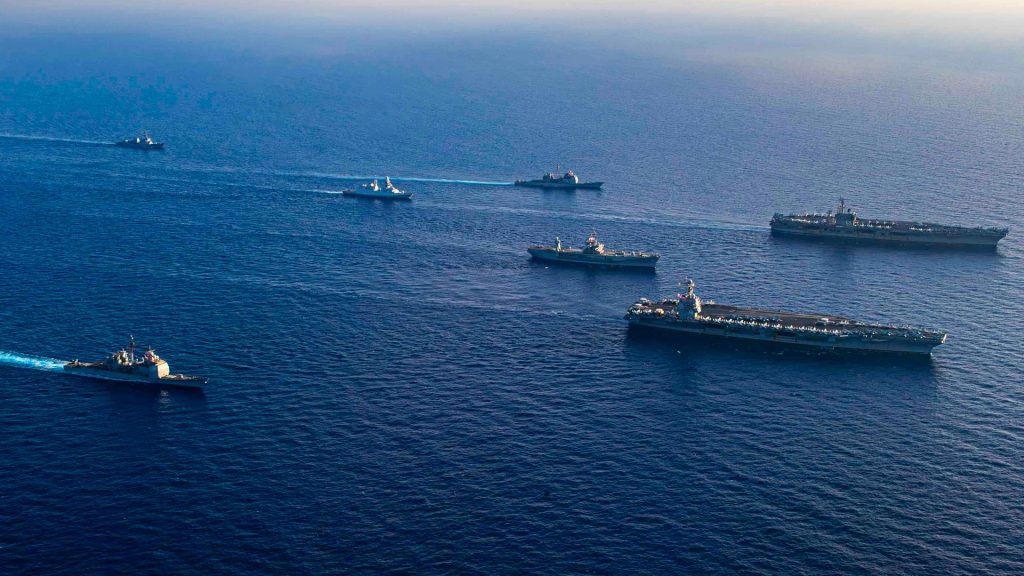The US isn’t ready for a major two-theater war. How can we prepare?

The United States is not ready for a two-theater war, according to Sen. Mike Rounds, R-S.D., a senior member of the Senate Armed Services Committee. Rounds made the comment after the Trump administration asked Congress for $1 trillion to spend on the military in fiscal year 2026.
“We have to have an increase in the ongoing defense budget,” Sen. Rounds told reporters. “We are at a time in which if we ever get into a serious conflict, we will have a conflict in more than one theater. We are not prepared for that today. We’ve got to prepare for it, and that means new technologies, new capabilities and a lot more in our in our capacities in terms of, just the amount of ammo that we’ve got available and the types of systems that we’ve got in order to respond to two very aggressive adversaries who are investing in their militaries.”
The two adversaries actively investing in their militaries are China and Russia.
So why is the United States not prepared for a two-theater conflict, considering we already spend close to $1 trillion per year on defense?
Straight Arrow News spoke with Mathew Shoemaker, a former intelligence officer with the Defense Intelligence Agency, to help explain and explore those problems.
This transcript has been edited for clarity and brevity.
Ray Bogan:
Do you agree with Sen. Rounds’ assessment?
Matthew Shoemaker:
Short answer, kind of. He kind of alludes to — if we get into one war, we’re therefore gonna get into a couple or a few wars. That’s an assumption. There is no guarantee that that’s gonna happen.
But he is 100% right about how we need more artillery production. We need more production with regards to military equipment and material. A lot of our stuff is a lot older than what our adversaries, such as China in particular, are making. So we certainly need an influx in production capability with regards to that.
And another element to it as well is — is the solution really just throw more money at the problem? What DOD really needs to do, they really need to go into their books, they need some sort of independent organization to look at the budget and say, ‘Are these elements that we currently have, is that actually necessary? Or can we save that money and put it into a more useful place elsewhere?’
Ray Bogan:
So you just said throwing more money at the problem may not be the answer. Let’s put that into perspective.
In 2024, the federal government spent $1.6 trillion on discretionary budget items. So that covers everything other than Medicare, Medicaid and Social Security. Of that $1.6 trillion, they spent $842 billion on defense programs and $750 billion on literally everything else.
How do we still have a readiness issue when we spend that much money on the military?
Unbiased. Straight Facts.TM
In 2024, the United States spent $842 billion on defense. President Trump is requesting a record $1 trillion for 2026.

Matthew Shoemaker:
I ask myself that question every single day. Up until about last year, when they alleviated this problem, the estimation was that roughly 20% to 25% of all military personnel were either food insecure or at risk of being food insecure. So that begs the question: What in the world are we spending our money on?
That’s why I came to the conclusion that throwing more money at a problem is not the solution. It’s how we’re spending that money. The Pentagon has a big problem because it’s the fox guarding the hen house. A lot of these three, four-star generals and admirals, as soon as they get out of the military, they go and they work for defense contractors.
On the one hand, they’ve got a lot of institutionalized knowledge. They know exactly what is needed and who to talk to about that, so there is a value in that. But on the negative side, that’s a great place for corruption.
Providing for a world-class military is expensive. You got to spend to be the best. But we got to make sure that we’re getting the best bang for our buck, and I do not think that that’s the case at this point in time.
Ray Bogan:
You and the senator also mentioned modernization. As an example, Houthi rebels were using drones, which cost an estimated $2,000, to attack commercial vessels in the Red Sea. The Navy was shooting those drones down with missiles that cost $2 million apiece. In addition, Houthi rebels in Yemen have used missiles estimated to be in the five-figure range to shoot down seven MQ-9 Reaper drones that cost $30 million apiece.
Should the U.S. be using these advanced, expensive technologies to take out rudimentary weapons?
Matthew Shoemaker:
That really is a philosophy question more than anything. Do we want to go towards a high-number system that might cost very little? So for example, we buy a ton of very small drones, and let’s say they’re kamikaze-type drones or so that might cost like a million dollars or so per system, and then just flood the area with it. That certainly would, in theory at least, protect a lot of lives, and it would be a good bang for the buck.
Whether or not we have the political will to achieve that — I don’t think it’s there at the moment. It’s not part of the political discussion with regards to the military. And when a system like the F-35 can cost upwards of $150 million per item, there are a lot of very high-profile companies that want to make sure that they get their voices heard.
Ray Bogan:
What makes a country prepared for a two-theater war?
Matthew Shoemaker:
Yeah, so within that question is going to have to be a whole lot of assumptions made about what that two-theater war looks like. Who it’s going to be, what time of year it might start, what the objectives of that two-theater war might be and the capabilities of those hypothetical countries.
If we wanted to take, for example, Russia-China-U.S., that’s going to be very different from a North Korea-Iran two-theater war.
China, you’re going to focus on access denial of the South and East China Sea, in which case that’s going to be very heavily Navy oriented, and to a certain extent Air Force. A European theater-style war, which is what we planned for for the better part of the Cold War, was very heavy with regards to the Army.
In February 2022, the Russians attempted to open up a three-pronged attack into Ukraine. It was going to go from the east, the north down into Kyiv, and then to a certain extent from the southeast — they were trying to do a three-pincer approach. That requires an extensive amount of planning, extensive amount of logistics to make sure warfighters have the equipment and the replenishments that they need.
Ray Bogan:
You just mentioned a conflict with China would be reliant on the Navy and Air Force. The Navy is trying to expand its warship fleet from 295 today to 390 by 2054. The Air Force is trying to replace the F-22 Raptor with a next-generation fighter in the 2030s. In both those cases, you see it’s going to take years or decades. Adversaries aren’t going to wait for us to be ready. Certainly, China isn’t going to wait for the U.S. to move on Taiwan. So while those programs are underway, what do you do in the meantime?
Matthew Shoemaker:
Built into the question is the assumption that it’s only the U.S. and only China. In which case, that is a big problem, right? In the sense of China has very specific goals that they want to achieve in theory, with regards to their military and with regards to their Navy, i.e. anti-access, area denial of the East and South China Sea. So that’s very limited in scope in what they do. The United States has global commitments, in which case, the United States is very hard-pressed to focus all of its resources just on the East and South China Seas. China has a much easier time doing that.
Over the years, the United States reached out to countries such as Japan, Philippines, Australia in an attempt to augment the American capabilities. So in the event that the United States and China ever do go into a shooting conflict, the United States can draw on resources and allies in the area that number one, know the area a lot better. They have their own resources relatively close to the theater itself, and the United States can augment its capabilities and act as a force multiplier.
Ray Bogan:
So final question — you’ve mentioned multiple times you have to assume certain scenarios when planning, which means to me that the military has to be ready for anything. You think about times in history like Lend-Lease during World War Two where the United States was not prepared and pretty much needed every able body to meet the moment. Do you think the United States is prepared to do that if necessary?
Matthew Shoemaker:
Planning is one of the critical elements of any modern military. I myself was not a military planner, but one thing that I did learn from them along the way was that you’re never going to be able to make a perfect plan. Because the enemy always has a say.
It’s impossible to plan for every single contingency. Having said that though, what the United States is able to do is having the institutionalized knowledge of how to think quickly on your feet, how to plan quickly when things do go sideways so you can correct for it.
And in terms of whether or not the United States can ramp up production to fight a two-front war, very rarely do we invest the way that we probably should. But once there’s a problem, we have, at least up until this point, always risen to the challenge.





